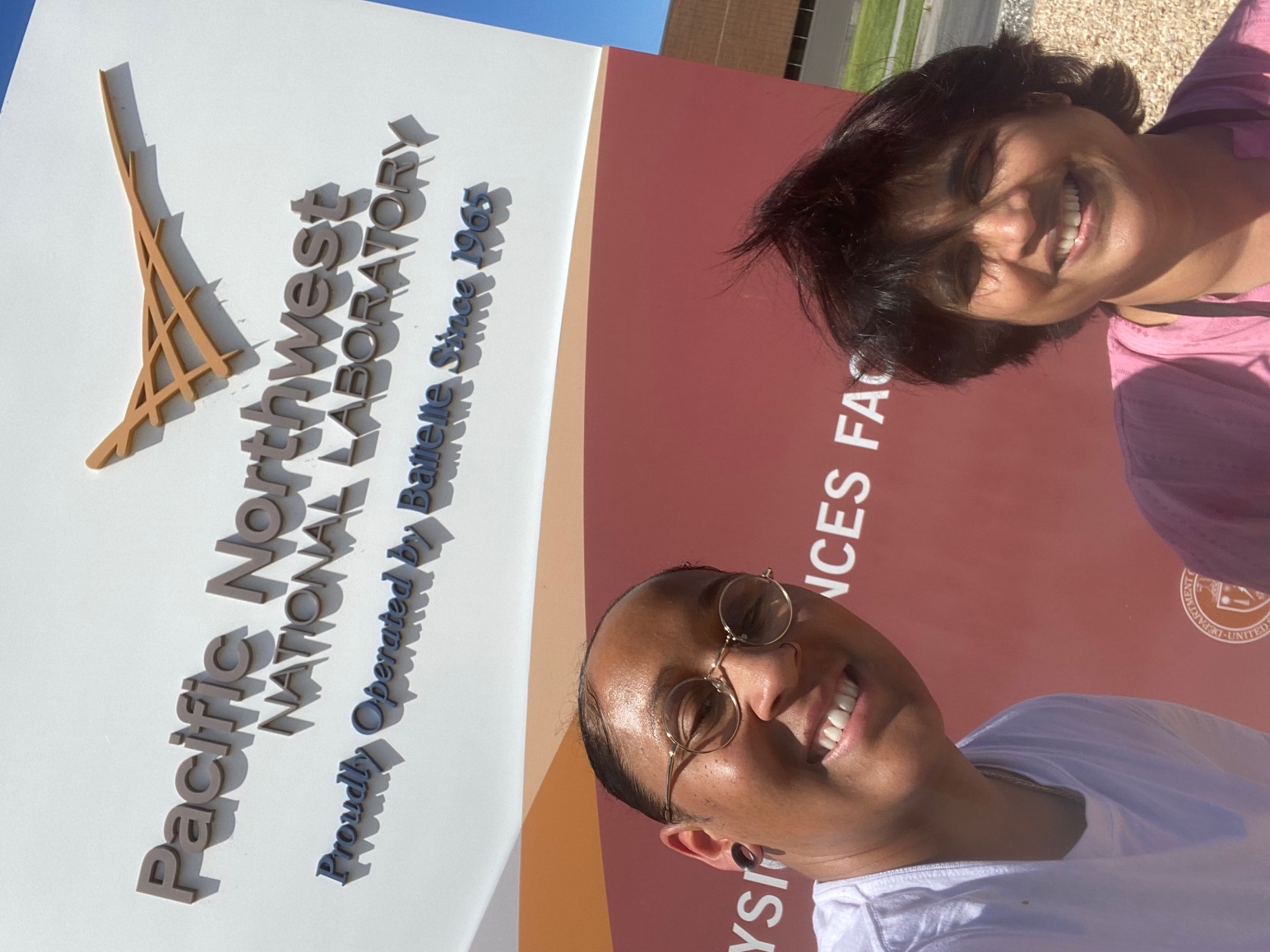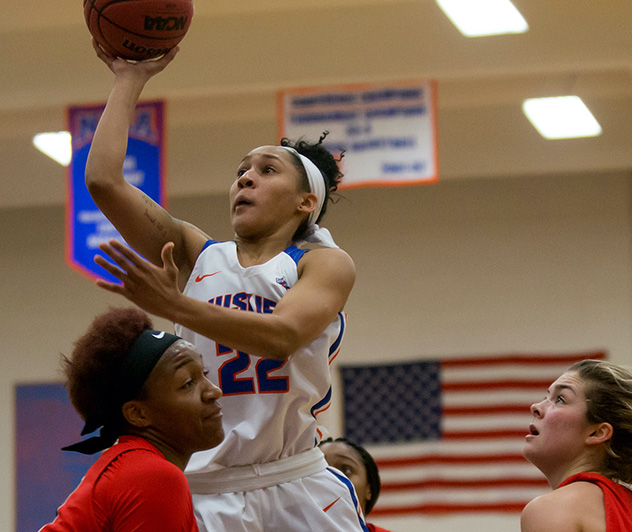Medical Physics Graduate Student Sydney Carr Shares her Research Experience
Houston native Sydney Carr is an LSU graduate student participating in “Novel X-ray Interferometry Imaging of Plant Root Systems” research and focuses on testing a portable (and removable) low-dose MPG interferometry system. She completed her undergraduate degree in physics at Houston Baptist University. While there, she also played 4 years of Division-1 Women’s Basketball for the Huskies.
Can you describe your experience at LSU Physics & Astronomy in one word?
Memorable.
What sparked your initial interest in physics?
When I was younger, I was always interested in science as well as sports, specifically basketball. I was also fascinated with how the basketball could make such crazy trajectories during games and practices. In eighth grade and throughout high school, I became infatuated with the science that answered all my questions — physics. I then decided to major in physics at Houston Baptist University, as well as accepting a full-ride athletic scholarship. Eventually, this led me to where I am today as one of LSU’s graduate students.
What do you like/love about LSU Physics & Astronomy?
I love how diverse and family-oriented our department is. Even though the Medical and Health Physics Program is a little family of its own within the whole department, I love how warm and welcoming the environment is in LSU Physics & Astronomy.
Why did you choose LSU for graduate school?
Specifically, LSU’s Medical and Health Physics program ) is CAMPEP (Commission on Accredited Medical and Physics Education Programs) accredited, which is highly sought out in my field. It essentially means that LSU meets at least the minimum requirements and standards for an educational program to provide a consistent quality education of medical physicists. LSU also waived tuition and stipends for their master’s students, which is huge since most programs don’t offer this benefit. Plus, I am Creole and most of my family is originally from Louisiana, so living in Baton Rouge is like being at home when it comes to the food, culture, and crawfish!
What interesting experiences or things have you learned during your time at LSU?
One of the most interesting experiences I had was the opportunity to travel across the country to Richland, Washington, to the Pacific Northwest National Laboratory to conduct research experiments on x-ray computed tomography machine at their EMSL (Environmental Molecular Sciences Laboratory) facility, which is a Department of Energy Office of Science user facility on PNNL’s campus. It was so cool to experience the protocol, screening, and overall work at a government lab. I also got to experience doing work at Pennington Biomedical Research Center and at the Center for Advanced Microstructures and Devices (CAMD) here in Baton Rouge. I have learned such a variety of hands-on experimental skills as well as learning the many concepts, physics and theories behind the systems I worked on. I feel if I didn’t attend LSU for graduate school, I wouldn’t have gotten to add these experiences and new, wide variety of skills upon completion of my master’s degree.

How has your experience been as a research assistant?
Very rewarding. I feel as if being a research assistant has filled in specific holes within my didactic learning as well as within the building of my professional skills. Before I was a research assistant, my time was always managed around designated class times. Now, I have become more vigilant concerning my time management by carefully sorting my work week into designated times for my research, miscellaneous work, various meetings with my advisor, Dr. Joyoni Dey, as well as allowing myself “me-time” during the week. I also have to make time for my involvement as a councilman for NSBP (National Society of Black Physicists), a society that strives to promote the professional well-being of African-American physicists within the scientific community and within the society at large.
Some advice I have for prospective research assistants at LSU would be to first choose an advisor not just based on pure research topic interests but who you will work very well with together regarding personality type — how they supervise and run their research lab as examples. I chose Dr. Dey based off not only interests but because we work well together, and she is very understanding regarding mental health days and breaks. Lastly, become the best expert possible at time management so that the transition into research work is easier.
Are there any professors in particular that have acted as mentors during your academic journey?
My advisor Dr. Joyoni Dey and our program director, Dr. Wayne Newhauser. Both were, and still are, people who constantly believed in me since the day I stepped foot into the program. They are always open to any technical questions I may have, as well as life questions, creating a safe space for any and everyone. Specifically, Dr. Dey took me on as a research assistant and constantly encouraged me on my abilities, as well as helping me along the way whenever I needed.
What was it like getting to investigate advanced X-ray interferometry concepts on a commercial CT system with Dr. Dey?
Super cool honestly. It was my first time working on a commercial CT (computed tomography) system where a series of x-ray images are taken at various angles around a sample and combined using computer processing to create cross-sectional slices of the sample. And I had the best advisor to help guide and teach me. I feel like it added to the strength of good dexterity with my hands (a skill I need while doing clinical work) because I was required to move the MPGs in certain coordinate directions sometimes within 0.01mm using a joystick.
What made you interested in testing a portable (and removable) low-dose Modulate Phase Grating interferometry system (MPG) where incident of the x-ray beam is controlled?
In my graduate imaging physics course, I learned about the important role the small spatial resolution is for mammography and the role it plays to detect any malignant microcalcifications within the breast that can often be indistinguishable from normal breast tissue. Once I entered my Advanced Imaging Physics course at Mary-Bird Perkins Cancer Center under Dr. Dey, I was exposed to the intriguing world of digital image processing and one of its many applications, low-dose MPG interferometry. I became interested in the way that not only can you recover x-ray absorption images but phase-contrast images that provide even more information of the sample being imaged, all within one single x-ray scan. I became interested in testing a portable (and removable) system because this being accomplished could open doors for clinical applications. Specifically, within my field, my passion for testing a system like this originated from the instilled importance of an adequate diagnosis for cancer patients in order to better our treatment planning and delivery accuracy.
How is your research beneficial?
Within my desired concentration of radiation physics, mammograms require a very small spatial resolution, or the ability to distinguish two separate structures from each other, to adequately detect microcalcifications, also known as calcium salt deposits (that are considered robust markers for breast cancer), within the breast that can often be indistinguishable from normal breast tissue. A portable (and removable) low-dose MPG interferometry system for diagnosis produces images recovered from x-ray absorption as well as from phase-stepping, a part of phase-contrast imaging which is just using the information concerning how an x-ray beam shifts, or changes phase, when it passes through a sample. By using a phase stepping technique of the MPG, we acquire phase-contrast images based on x-ray phase shift and scatter (dark-field) all within the same scan without increasing the dose to the patient. Therefore, this x-ray interferometry system has the potential to yield higher detection sensitivity and specificity than conventional mammography or breast computed tomography (BCT), a system that uses the same techniques as a traditional CT machine like I explained before, but now just to recreate a 3-D image of the breast tissue. Eventually, this low-dose MPG interferometry system could be implemented into a multi-contrast BCT system in the clinic after continued testing and addressing of any critical issues.
Can you describe the reality of being in physics compared to the stereotypes of physicists?
Physicists are usually depicted as a white man with wild hair in a lab coat, tirelessly trying to solve a long, drawn-out equation on a chalk board. Physicists come in all shapes and sizes, within an incredible number of different fields and aren’t just limited to solving theoretical problems but experimental ones too. Physicists can be female also.
What do you think it means to be part of an organization like the National Society of Black Physicists?
I think being a part of NSBP is extremely important. Per a 2020 Forbes statistic, African Americans only account for ~3% representation in the field of physics. This is extremely low due to a multitude of reasons that can be fixed and extinguished by promoting the professional well-being of students and physicists within the international scientific community and within society at large. To be able to be apart of that movement alone is invigorating.
What is your role in the organization?
I am an active member of the NSBP Student Council. I am also the chair of the LGBTQIA+ Committee and a member of the Women in Physics Committee. Being a part of NSBP’s student council as well as the committees has been extremely rewarding. I enjoy the connections I get to make by meeting other young black physicists as well as ones that have ripened into a long career. I got the experience of setting up and working a professional conference, proposing ideas to elicit change for our small community we have in the field of physics, and representing people who go through similar experiences as me during our careers and in life.
What kept you motivated while pursuing your degree?
My family. One of the many reasons that I pursued a medical physics master’s degree was because my family has unfortunately been riddled with deaths due to cancer. Every time I get down or feel defeated over something, I think about how I can provide the same love and adequate care for someone else’s family member during their lowest points in their lives or even in their last days. Essentially, me completing my degree is not only life changing for myself, but potentially for thousands of other lives I encounter during my career.
Do you have words of advice for upcoming or current students?
Don’t ever give up. A career within the fields of Physics and Astronomy can be quite challenging at times but never impossible. If you are a student within the department, there is a reason you are here, so don’t lose sight of that. You BELONG here. Continue to surround yourself with others of the same goal as you and support each other throughout your beautiful journeys through this field.

Hobbies?
Coming from playing Division-1 Women’s Basketball, my main hobby is exercising. I love weightlifting and going for a good jog in the mornings. If I’m not doing that, I enjoy reading a good Stephen King novel, fishing, or going on a foodie run somewhere with my girlfriend.
Any graduation plans?
I plan on taking on a 2-year, Medical Physics Residency Program that emphasizes clinical work within oncology and radiotherapy.
Dream career path or profession?
My dream career path after graduate school would be to start in a medical physics residency program back in my home state of Texas. I wish hopefully to then accept a full medical physicist position within an oncology department, pursuing certain specializations in Gamma Knife and SRS modalities.
###
Feature by Savannah St. Romain, LSU Manship School of Mass Communication.
Contact : Mimi LaValle
LSU Department of Physics & Astronomy
225-439-5633
mlavall@lsu.edu